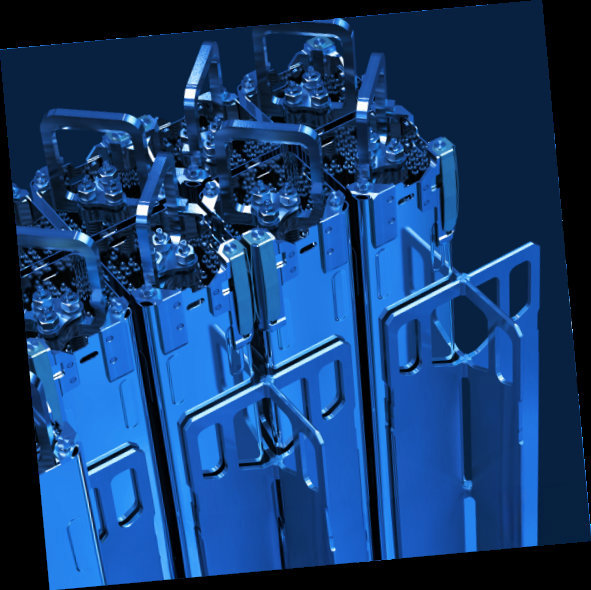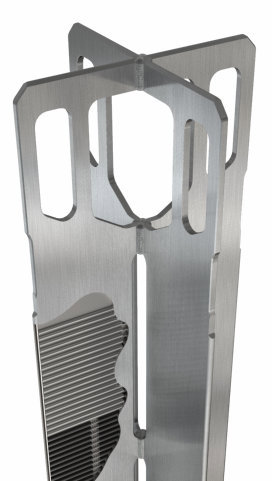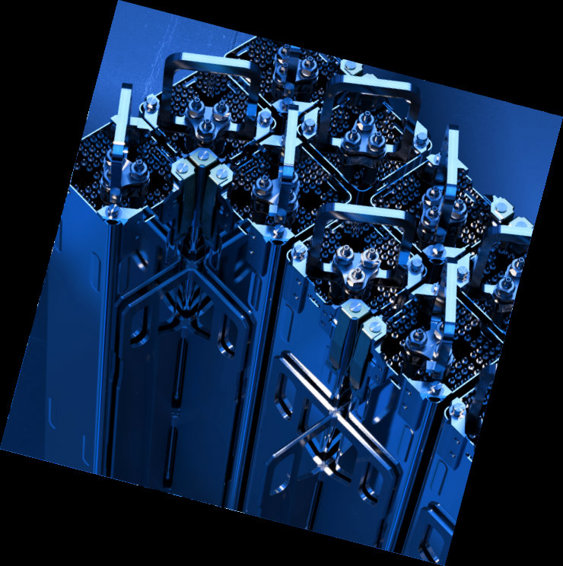Background
Today’s Boiling Water Reactor (BWR) Control Rod Blades (CRBs) must meet the highest-ever operational demands while contributing to reduced operational costs for the plant operator.

Westinghouse
Trident X CRB design
Description
Westinghouse cruciform-shaped BWR CRB design consists of four solid stainless-steel sheets welded together. Each sheet has horizontally drilled holes to accommodate neutron absorber material, consisting of both boron carbide (B4C) and metallic hafnium. The neutron absorbers placed in these holes are carefully designed to enable the optimal nuclear performance of this key safety core component.
Trident X CRB Design
The advanced high-duty Trident X CRB, primarily aimed at power-shaping, includes Hot Isostatic Pressed (HIP) B4C pins as the main absorber material together with a hafnium tip. A gap is designed between the pins and the walls of the drilled holes such that the B4C, which swells due to neutron capture, does not interact with the structural material in a way that would create detrimental stresses leading to cracking (Irradiation Assisted Stress Corrosion Cracking). In operation, the hafnium pins of the Trident X CRB have a much slower depletion rate than the B4C absorber. This hampers the long-term weakening of its nuclear performance as a result of the sustained neutron irradiation of the tip of a CRB, when fully withdrawn. Furthermore, hafnium does not swell because of neutron capture, eliminating the development of detrimental stresses. The hafnium tip has been a proven feature in Westinghouse CRBs for over 40 years.
Experience
Westinghouse began designing and manufacturing BWR CRBs
in the mid-1960s. The first product, an all-B4C CRB called CR 70,
started operation in 1970. The robustness of the Westinghouse BWR
control rod design has been proven with over 45 years of operation on
some original CRBs. This proves the robustness of the Westinghouse BWR control rod design, based on its unique horizontally drilled absorber holes. Westinghouse introduced the non-swelling/slowly depleting hafnium tip in the 1980s, after recognizing that the CR 70 CRBs, even when fully withdrawn from the core, were still exposed to significant neutron irradiation (fluence) at the tip.
The introduction of the CR 99 concept relies on solid HIP B4C pins with carefully
engineered gaps, dimensions, and tolerances. Trident X represents the 5th generation of
the CR 99 CRB design and leverages our design and operating experience to improve upon expansion gap margins between the HIP B4C pins and the inner blade wall. For Trident X,
the expansion gap is 29% larger than the CR 99 Generation 3, and 70% larger than the CR 99 Generation 2. Trident X combines the engineered gaps for the HIP B4C pins with the low depletion rate of the hafnium tip. The development was driven by the increased neutron fluence in the lower part of the core, due to the use of enriched uranium fuel bottom blankets in some European plants.
Benefits
- High-duty CRB with HIP B4C pins as the main neutron absorber material
- The HIP B4C pins are highly resistant to dissolution and leakage in water
- Hafnium tip with limited depletion rate, for sustained operation in fully withdrawn position
- Structural material and design with high resistance to Irradiation Assisted Stress Corrosion Cracking (IASCC)
- Guarantee against cracks in the top node due to IASCC
- Handle integrated in blade wings
- Trident X can be introduced in US BWR reactors without requiring new licensing
- Low-Cobalt content
- Designed with a mechanical life longer than the nuclear lifetime
Westinghouse has delivered more than 7350 BWR CRBs.
Westinghouse BWR control rods are licensed in the United States, Spain, Switzerland, Sweden, Finland, Germany, and Taiwan.





